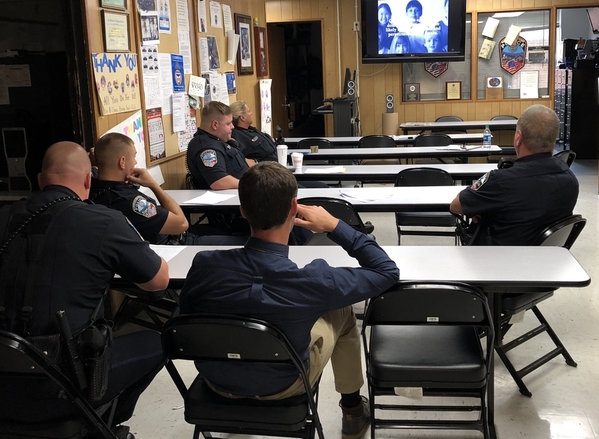Since first hearing about trauma-informed care in 2014, and then setting out on a journey to bring this education to my community, I’m constantly amazed at how this message is being embraced in Johnson City, Tennessee. After partnering with Dr. Andi Clements from the East Tennessee State University Psychology Department, in a little over 2 years we have trained over 2,500 professionals! This growing number of passionate advocates includes staff within the public schools, the state university, and emerging interest among healthcare partners. Together we are now working to become a more resilient city. In the dark tunnel of an Appalachia opioid epidemic, ACEs science has now allowed us to see a hopeful light at the end of it.
In June of 2016 we first began holding bi-monthly meetings to create a Trauma-Informed System of Care. This has now grown to 28 affiliated organizations represented. We frequently have nearby cities reaching out for ACEs training and then asking for coaching on creating their own systems of care. I’ve also had inquiries from a growing number of other states wanting to learn more our System of Care. Just last week our System of Care efforts were boosted by the Northeast Region of the Tennessee Commission on Children and Youth (TCCY) announcing their plans to align dozens of coalition partners who are trained in the Tennessee Building Strong Brains initiative, with our System of Care as a next step for TCCY in creating an ACEs Knowledge Mobilization network.
Being embedded in a police department, it has long been my desire to develop a trauma-informed policing training. Much of the trauma-informed care training we have offered to professionals consists largely of a composite from the SAMHSA course, “Trauma-Informed Approach, Key Principles and Assumptions” along with content from the Tennessee “Building Strong Brains” training. Depending on what kind of organization we are training, we will provide examples of trauma-responsive applications (which ACEs Connection provides a wealth of access to) in order to enable those being trained to begin immediately after training to take some next steps. Over two years, we’ve developed dozens of variations of this four hour training in order to reach just about any kind of service provider imaginable. In the spring of 2017, I offered a three hour in-service to our School Resource Officers in conjunction with our department launching the Handle With Care Program in partnership with the Johnson City Schools. This was a first step towards training members of law enforcement locally.
In December of 2017, I was honored to be an invited presenter on the Law Enforcement panel at the MARC National Summit in Philadelphia. Not only was it an honor to present at this event, it was equally as exciting to meet in person many who I consider pioneers in the ACEs movement. Sharing the Law Enforcement panel with me were Major Darren Ivey from the Kansas City Police Department, Interim Chief Robert Sears of the Albany, New York Police Department and Kevin Bethel, Senior Policy Adviser, Stoneleigh Foundation and Drexel University. By hearing how other law enforcement agencies were beginning to implement trauma-informed concepts provided me plenty of ideas for moving forward.
After spending a few months researching law enforcement trauma-responsive applications, I developed a three hour officer in-service on “Trauma-Informed Policing.” After reviewing it with our Chief and our Administration Major to receive their input and support, I reached out to staff in our training division, to submit this in-service for POST Certification in the state of Tennessee which it went on to receive.

This in-service will help officers see the benefits in learning about trauma and how this knowledge can help to improve criminal justice responses. We also discuss the nature of police work. Though we refer to the police as law enforcement officers, meaning the enforcement of criminal law, (i.e. investigating crime and apprehending criminals) this is only one of several functions that the police perform. Police respond to calls to help people who need emergency assistance of all kinds. Police are often on the scene in situations that are traumatic in nature.
Module one of the training has these learning objectives:
- To gain a shared understanding of trauma
- To recognize how trauma effects the brain
- To be able to identify trauma
- To understand ACEs (Adverse Childhood Experiences)
- To be aware of the prevalence of trauma.
This information is taken from the SAMHSA, “Trauma-Informed Approach, Key Principles and Assumptions” course. However, when covering what trauma looks like, I incorporated materials from the “International Association of Chiefs of Police and Yale Child Study Center; 2017 - Enhancing Police Responses to Children Exposed to Violence: A Toolkit for Law Enforcement.” This section is entitled, “What Traumatic Stress Reactions May Look Like On-scene” and examines physical, emotional, cognitive and behavioral reactions officers might encounter on scene. At the end of this module I included showing the “Chad’s Story” video from Futures Without Violence, Childhood Trauma – Changing Minds curriculum. (https://youtu.be/sFH6GR0ASKg ) This video demonstrates how mentoring and friendship for a few hours a week from his high school football coach, helped to mitigate the effects of ACEs in Chad’s life. I added this because at times, police officers respond frequently to the same households or neighborhoods. Often officers develop some report with youth or children living there in order to provide them a positive role model and Chad’s Story reinforces the importance of this.
The second module of the in-service addresses:
- Identifying trauma-informed policing practices
- Identifying tools to help de-escalate crisis situations, maintain safety and expand professional satisfaction.
- Considering how TIC could be used in pre and post crisis intervention
- Importance of officer “self-care.”
For examples of trauma-informed policing I discuss, work done by the Wilmington, Delaware Police Department in 2005-2006 as reported in “Creating a Trauma-Informed Law Enforcement System, NCTSN Service Systems Briefs v2 n1, April 2008, NCTSN.org.” I also included “Handle With Care” which was developed by the West Virginia Children’s Justice Center. Handle With Care is simple to implement and an intervention that does not cost either police or educators anything to offer. If a law enforcement officer encounters a child during a call, that child’s name and three words, HANDLE WITH CARE, are forwarded to the school/child care agency before the school bell rings the next day. The school has a trauma understanding so that traumatized children are “Handled With Care". If a child needs more intervention, trauma-focused mental healthcare is then available by referral. A third example of trauma-informed policing discussed is called, “Clergy Patrol.” In 2017, Norfolk, Virginia Chief Larry Boone implemented an idea to bridge the gap between police and community. Recognizing the most difficult neighborhoods in Norfolk were usually just down the street from a church he created, “Clergy Patrol” to which the local pastors bought in quickly. Clergy Patrol engages with the police instead of waiting on a community crisis, and are proactive in building relationships, mediating conflict, trying to find ways to deescalate situations. When officers respond to a call, the clergy stay in the patrol car. Once it’s safe, they can minister in any way they deem needed on a scene. Clergy are there to offer support as needed by prayer, a few words of calming, counseling or whatever the case may be.
I also cover how to reduce ACEs within a community by creating a System of Care. I provide an update on the local System of Care we are creating. This approach came from the 2014 SAMHSA Concept Paper entitled, “SAMHSA’s Concept of Trauma and Guidance for a Trauma-Informed Approach” which recommended creating community wide educational programs on the trauma-informed approach, which we have been doing now since 2015.
For helping officers identify tools to help de-escalate crisis situations, maintain safety and expand professional satisfaction I incorporated “Tactical Breathing” which came as a recommendation for officers from the ICAP, “Enhancing Police Responses to Children Exposed to Violence: A Toolkit for Law Enforcement.” In the same way we have been teaching local educators to not respond to a child who is operating out of their “downstairs” brain by going downstairs themselves, this lesson can be easily adapted to police officers by using “tactical breathing.” Other tools for officers include considering their own behavior and the need to provide “respect, information, safety and choice” on scene. Education is also incorporated from the ICAP report on “age appropriate effective police responses on scene.” This helps officers understand how they can reduce the amount of trauma children and youth are exposed to once they respond to the scene. Lastly, other tools include reviewing “Gestures” from Futures Without Violence that can be easily applied by police officers. Lastly in this section I included the “Cops, Kids and Domestic Violence” training video from the National Child Traumatic Stress Network which contains five core messages for police officers responding to domestic violence calls where children are on scene. (https://youtu.be/o2-LZBtXlxg )
The final content of this in-service training addresses the need for officer self-care. Major Ivey from the Kansas City Police Department shared with me the Professional Quality of Life Scale which he uses in training his department. This free, online, self-scoring assessment can be used by those in any compassion professions. This instrument scores for Compassion Satisfaction, Compassion Fatigue and most alarming for members of law enforcement, Secondary Trauma. I discussed using this tool with our Administrative Major who suggested I meet with the Director of Human Resources for input about the best use with officers. As a result we are recommending in training that each officer take this assessment at least yearly. Results are never reported to their supervisor nor does it become a part of the officer’s employee file. In the training I describe how the ProQUAL tool is simply for the officer to self-assess that they are dealing with the stress of the job in a healthy way. Our Human Resources Department also provided a confidential phone number to access our Employee Assistance Program which insurance covers 6 free visits for. The training recommends officers utilize family, friends, peers and department chaplains as part of their safety plan.
Recently our Chief enlisted my help to write a grant which if we are awarded funding, it will enable us to partner with the local mental health provider and receive a full time case manager designated for police referrals. In this program we would be specifically referring individuals identified by police calls and outreach conducted to a case manager for follow up. This program would aim at helping those who are homeless and disadvantaged youth or children. As the Johnson City Police Department is moving forward in becoming trained in Trauma-Informed Policing, we hope soon to begin to implement these principles as a first step towards reducing hospitalization and incarceration for some by connecting them to the proper services they need.



Comments (5)